World oil prices
At the end of the first trading session of the week (June 2), according to Oilprice, Brent oil price increased by 2.29 USD/barrel, equivalent to 3.65%, to 65.07 USD/barrel and WTI oil price increased by 2.25 USD/barrel, equivalent to 3.7%, to 62.52 USD/barrel.
Thus, after two consecutive weeks of price declines, Brent and WTI oil prices both increased by more than 3%, despite OPEC+ maintaining its plan to increase production in July. The increase in oil prices may be due to forest fires in Alberta province - Canada's oil production center - threatening supply and President Donald Trump's new tax threats weakening the US dollar (USD).
World oil prices increased after two consecutive weeks of price declines. Illustration photo: Oilprice
According to Reuters, forest fires in the Canadian province of Alberta have affected about 7% of the country's total crude oil production as of June 2.
At least two oil sands mining companies in the southern, industrial hub of Fort McMurray evacuated workers from facilities and temporarily halted production over the weekend as a precaution.
“The Alberta wildfires are now starting to impact the global oil market,” said John Kilduff, partner at Again Capital in New York.
Another factor weighing on oil prices is the broad-based weakness in the US dollar, amid concerns that Mr Trump's new tariff threats could slow growth and stoke inflation.
A weaker dollar makes dollar-denominated commodities like oil cheaper for buyers using other currencies, boosting demand in oil-importing countries and potentially supporting oil prices in the short term.
Illustration: Boston
Oil prices were also affected by heightened geopolitical risks following Ukrainian drone attacks on Russia over the weekend, according to Jorge Leon, an analyst at Rystad Energy.
Meanwhile, mixed signals from U.S.-Iran talks added to market tensions. An Iranian diplomat said Iran may reject a new U.S. proposal to resolve the decades-long nuclear dispute, despite some progress made by delegations from both countries after a round of talks in Rome last month.
The Organization of the Petroleum Exporting Countries (OPEC) and its partners, collectively known as OPEC+, have decided to increase production by 411,000 barrels per day in July to regain market share and punish members that have exceeded their quotas.
According to Reuters, analysts at Goldman Sachs - a major investment bank in the US, predict that OPEC+ will make another production increase of 410,000 barrels/day in August.
"The current tight oil supply situation, combined with positive global economic data and seasonal increases in oil demand during the summer, suggests that the slowdown in demand will not be large enough to prevent OPEC+ from continuing to increase production when it decides on August production levels on July 6," Goldman Sachs wrote in a report.
Analysts at Morgan Stanley also believe OPEC+ will continue to increase by 411,000 barrels per day per month, bringing the total increase to 2.2 million barrels per day by October.
Domestic gasoline prices
Domestic retail prices of gasoline on June 3, specifically as follows:
E5 RON 92 gasoline is not more than 19,196 VND/liter. |
The above domestic retail prices of gasoline and oil will be adjusted by the Ministry of Finance and the Ministry of Industry and Trade in the price management session on the afternoon of June 5. World oil prices increased in the first trading session of the week, affecting domestic gasoline and oil prices. This week, gasoline prices may increase, while oil prices remain stable.
In the recent price adjustment, gasoline prices increased and decreased in opposite directions. While the price of E5 RON 92 gasoline increased by 74 VND/liter, RON 95-III gasoline increased by 33 VND/liter, diesel oil price decreased by 269 VND/liter, kerosene decreased by 206 VND/liter and fuel oil decreased by 248 VND/kg.
Source: https://baolangson.vn/gia-xang-dau-hom-nay-3-6-sac-xanh-tro-lai-5048987.html



































































































Comment (0)